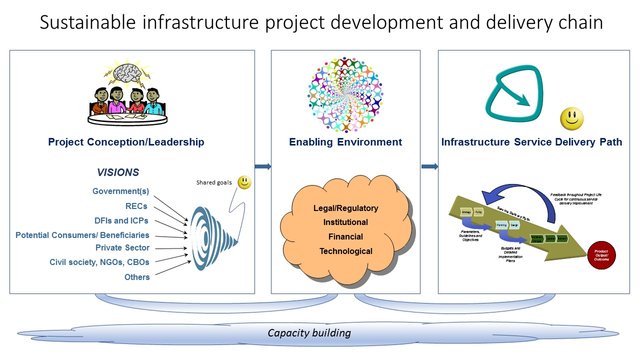African infrastructure: the enabling environment and where it fits (Part 4 in a series)
We're still scene-setting on infrastructure development in Africa, and trying to get our heads around a vast scope by putting some kind of framework to the thinking. Today we're going to introduce the glue that makes it all work...or not.

How cool is that Pixabay image? Lots of people collaborating to make something complex work. When the enabling environment for infrastructure works well, that's kind of what it looks like - a continuum of different people doing things together in a dynamic system producing order and elegance.
A quick recap of what we've considered so far
Let's recap the last three posts so we understand where we've been already.
- We touched on how infrastructure fits into Africa's development: we looked at where infrastructure fits into Africa's development by touching a bit on Agenda 2063 as well as the African Development Bank's 10 year strategy from 2013-2022
- Then we took a stab at understanding what infrastructure is, so we'd at least have a common language
- Economic infastructure, comprising
- Energy
- Water
- Transport
- Information and Communications Technologies (ICT)
- Social infrastructure, comprising
- health
- education
- housing
- other facilities as governments and societies may decide are needed for the smooth running of society and quality of life for members of society
- Economic infastructure, comprising
- Then we bravely (foolishly?) looked at a way of representing the infrastructure service delivery path, to introduce the idea that infrastructure organisations are accountable to their customers for quality and quantity of service delivered over time, in an affordable and sustainable way.
Framework for sustainable infrastructure project development
Today we'll put the infrastructure service delivery path we considered in yesterday's post into a broader context of infrastructure project development. Yesterday's post covered project conception to a degree, as well as the infrastructure service delivery path. Today we bring them together by introducing another concept: the enabling environment.
What is the enabling environment?
It's the secret sauce that allows an infrastructure project (that's the thing that ultimately gets built) to be financed, governed, implemented, owned and operated.
Legal and regulatory considerations
This is a vast field, but I'll do my best to deal with it succinctly here.
The legal environment allows (or prevents) public and private sector players to do what they want and need to do in order to deliver whatever they're doing in relation to the infrastructure initiative. Usually this is dealt with at the country level through legislation promulgated by government, and covers anything from land ownership laws to environmental, health and safety laws to corporate governance to what entity must regulate infrastructure service delivery (probably a series of posts on its own).
@mother2chicks shared an example of a state level law which really took me by surprise - that ALL residents of the State of Florida must be connected to the State's electricity grid. I hope I understood that correctly and am not misrepresenting a fellow Steemian. Why does this surprise me? Because it effectively grants an unfair advantage to the owner of the grid, the State utility, to access the consumer.
Another example at a different level - let's say municipal - would be bylaws on limiting water use for conservation purposes or whether households have the right to sell excess electricity they generate from their rooftop solar photovoltaic (PV) installations back to the city grid.
Regulatory considerations govern many aspects of infrastructure development and service delivery. These are usually managed in terms of a license granted by a regulatory body which reports to a ministry or other government entity, depending on government policy on how independent this regulator should be. It could be the line ministry, such as the transport, energy, water or telecommunications ministry, or it could be some
Legal and regulatory considerations have a strong influence over the business case for a particular infrastructure initiative. They can dictate whether or not the private sector has an opportunity to participate, or would even be interested in participating.
Did I hear anyone mention the potential for less regulation to unlock investment?
Institutional considerations
Here are a few questions to get you thinking about the power of institutions in your infrastructure service consuming life.
How strong are the public sector institutions in the sector where the infrastructure investment is going to take place? What is the capacity for quick decision-making, and inter-ministerial collaboration? How good are the linkages between strategy and policy, and planning and design? What power does the regulator have to grant a license? Do they have to ask the President (yes, that would be a red flag)? What is the technical and financial capacity to evaluate an idea or proposal from the local private sector? When there's a public procurement process, does everyone trust it? How good are the linkages between academia, government and the private sector? How robust are the local research institutions? How good and reliable is the census data? How up to date is the mapping?
Did I hear anyone mention the blockchain to introduce transparency and accessible databases?
Financial considerations
This is fundamental to the success of infrastructure development. Here are a few questions to get you thinking about this - but these are far from comprehensive. We could do a whole course just on financial considerations.
What is the capacity of the country to attract finance at reasonable rates? What is its investment rating? Besides the country's rating, how well are the country's utilities rated - at investment grade?
I worked with one utility in a country which will remain nameless which had not been able to produce audited accounts for over five years. They could not attract any investors to their electricity sector. Sometimes the utility is not "creditworthy", and potential investors start looking to the government for "sovereign" guarantees.
If the government is over-indebted - as if they'd maxed out on all their credit cards - they can't borrow any more and their current lenders won't let them guarantee any further borrowing on the part of the utility.
Did I hear anyone mention cryptocurrency?
Technological considerations
Technology availability, suitability and cost play a major part in infrastructure development. The advent of the internet has drastically changed how infrastructure services are delivered.
For example, automatic sensors with satellite communication capability have transformed how water levels are now measured in many remote rivers, lakes and streams. To build a dam, bridge or structures near a body of water, you need to have a record of how those water levels vary with the seasons and over the years.
This used to be done by local people (and in many cases still is - this is just to illustrate the role of technology). An agency would plant a special ruler by the water's edge, train a local person in how to read that special ruler, give him a notebook and a pen, and ask him to visit the site every week to record the reading on the ruler. Worked well in theory, not so well in practice. For instance, the pen might be needed elsewhere. Then how do the readings get recorded? We'll just remember them until we get the pen. Uh-huh. Or the person who was trained might decide to train someone else in the family to go and do the readings so they could continue to do the more important things they were doing previously. As we know, important messages can get lost in translation.
Did I hear anyone mention the Internet of Things?
That was just an intro to the enabling environment
We'll come back to it in future posts, but at least we're now on pretty solid footing when it comes to understanding that the enabling environment has a number of dimensions - legal and regulatory, institutional, financial and technological. And without it, the engine of infrastructure development has no oil, and it...
...siezes.
Bringing it together
Project conception

We saw yesterday what a powerful role leadership can play in project conception, by bringing stakeholders together to a common vision and shared goals. Many players are involved at this stage in African infrastructure development, including:
- governments (local, provincial/state/national)
- entities below national level are sometimes called "subnational"
- Regional Economic Communities (RECs)
- these are groupings of countries in Africa with responsibility for promoting regional development, integration and trade. In a future post I'll show you a map of Africa's RECs.
- Development Finance Institutions (DFIs) and International Cooperating Partners
- who support African countries' development plans and the implementation of those plans by providing material, financial and human resources
- Potential consumers and beneficiaries
- that's development-speak for you and me who'll be using the infrastructure and the services it will provide
- the private sector
- both international and local private sector entities have an interest in financing, implementing, operating and maintaining the infrastructure, where there is a business case for their involvement and the procurement process gives them a sense of comfort
- civil society, non-governmental organisations (NGOs) and community based organisations (CBOs)
- can represent the interests of the local community by being able to scale their capability
- Others
Leadership brings together the interests of these disparate stakeholders through a consensus building process which generally reflects the political culture of the country. This stage of the project development process is vital to building in institutional sustainability, as shared goals must be revisited, communicated, constantly brought into the context of the long term development plan in order for new participants in leadership over the years to have their voice and to interrogate the continued validity of the original goals. Contexts change! What was a good idea in the '70s (cathode-ray tube colour TVs, say) might be ludicrous now.

So leadership must ensure the consensus-building process is dynamic and relevant to the time.
Enabling environment
We've talked a lot about that today. Let's represent it with that cool Pixabay graphic.

Infrastructure service delivery path
We also talked a lot about the infrastructure service delivery path yesterday. Let's represent that with something simpler than that complicated arrow with backwards arrows and all the other busy stuff! It's basically a system which reports back to itself over time, so let's represent it with a really simple more or less virtuous circle pointing to happy people, infrastructure service consumers getting the service they want at a price they can afford.

Put those three together, what do you get?
If we put these ideas together and try to put them into some kind of timeline, more or less, it could look like the figure below. And insitutions are likely to get better with time as governance and leadership improve, as we've generally seen in Africa - so that capacity building has a net effect of improving how the whole process works.
We've discussed how the outcomes can influence the view of the original goals over time. Let's face it, much infrastructure can be built to last for 20 to 100 years! That's multiple generations. How often do younger generations agree with older generations on what's good for society? That's at least one reason why those feedback loops from the infrastructure service delivery path back to the enabling environment and back to project conception are so important in a systemic approach to infrastructure development, consistently focused on the why of the infrastructure.
Leadership from one generation to the next needs to take the best of the past, build on it and incorporate the possible of the future.

P.S. This will help us talk in future posts we can talk about infrastructure project preparation, and that's where we're going to be able to start talking about who (public and private sector) fits in where and how. And pretty soon we're going to introduce the concept of risk.
The good looking images are from Pixabay, some are ClipArt from over a decade ago, and the rest I drew (badly) myself. Thank goodness for Pixabay.

Team South Africa banner designed by @bearone
https://steemit.com/africa/@kiligirl/african-infrastructure-development-a-nutcracker-suite-part-1-of-i-m-not-sure-how-many-yet
www.steemit.com/@bestehemon
please
vote & Comment
@kiligirl, nice article shared about international development and infrastructure , your advices , thinking and efforts are awesome ,,UPVOTE
Thank you, @rabeel!😊😊
wow i'm thinking how things have moved on, i suppose historically people have migrated and created infrastructure based on the needs of their communities ie the availability of food or work or opportunity, even longer ago based on protection, as villages grew around fortified positions that they could run to in times of need,I guess now in more modern times without the need to hunt for food and the governmental protection we all tend to take for granted things have almost reversed , instead of mass population movements going in search of work , global companies now seek out the poorer countries that provide cheap labour and in turn that helps those countries develop their infrastructure, the interesting thing though is that there is now also a science behind the development of infrastructure and I guess it goes largely unnoticed by most as we mainly just expect it to be there now, whereas in the past it was something born from necessity that people had to construct just for survival, advancement is a wonderful thing and has it been for the better, id say absolutely \o/
What a great post. Thank you for expanding each step so that all can understand. Your mind is incredible @kiligirl
Another excellent and enlightening post @kiligirl! So now, sit back and ask yourself the question: "In Africa, why is it so very difficult to design, develop, finance and build infrastructure assets that provide services we all need?" All too frequently, I think, the answer is that the "soft institutional infrastructure" required (i.e., legal, regulatory, financial, political, etc.) is weak, poorly managed (or mismanaged) and, as a result, the perceived risks are simply too high to attract capital. Let's talk energy, for example. In order to achieve universal electricity access in Africa by 2030, estimates are that something on the order of US$ 1.0 TRILLION will be required--to invest in power plants, transmission lines, distribution, etc. Governments, donors, bilateral and multilateral financial institutions (i.e., public sector) simply don't have deep enough pockets. Attracting private capital is an absolute MUST. But, absent the "soft institutional infrastructure" that is transparent and well managed, it is an incredible challenge!
Thank you, @beantownboy, and that's an excellent question which you've gone some way to answering yourself. It will take more than the "political will" we've been hearing about for decades. After three decades in various niches of this vast ecosystem, I'm starting to think that a radical transformation in how finance works at consumer level is the best chance for transforming infrastructure service delivery. What do I mean by that? You refer to risk - as we've discussed in previous posts, creditworthiness of utilities and other bodies responsible for attracting finance is critical. But utilities sell infrastructure services at non "cost-reflective" prices, often below cost, partly because they know their end customers can't afford more. It's also due to the lack of creditworthiness of their customers themselves, and until African people can achieve a different level of financial independence, not necessarily in access to a new quantum of finance, but perhaps in how they access finance, they will not be considered creditworthy in the classical sense. This is an excellent case for the development of cryptocurrency ecosystems where micropayments can become the norm, not some futuristic vision. So perhaps I'm advocating even bypassing some of the "soft institutional infrastructure" as unnecessary and non-value-adding middleman.
The planning is commendable. I tried to understand the finance part but still something is not clear to me. Will the private sector be interested in financing the project? If it is not done, then how the government will raise the fund? Is it by imposing tax on people or by taking aid or debt from foreign financial institution.
Kiligirl my friend . Thanks for the shout out. The resteems etc. I have a list of things to discuss with you. Going to be out of touch till tomorrow. Have my Sister here visiting. Will catch up. Love Ellie Mae🐓🐓
Much love 😊😊😊😊
I hope you are very successful in your indeavors. Will be here when you return. Be safe and have a good trip. Love Ellie Mae🐓🐓
😊😊😊😊
Thanks for sharing. It's a long but good read ^^
The is a very impressive article on Africa. I must say your views are thought provoking.
Looks like an amazing plan! I cannot wait to hear the progress!!!